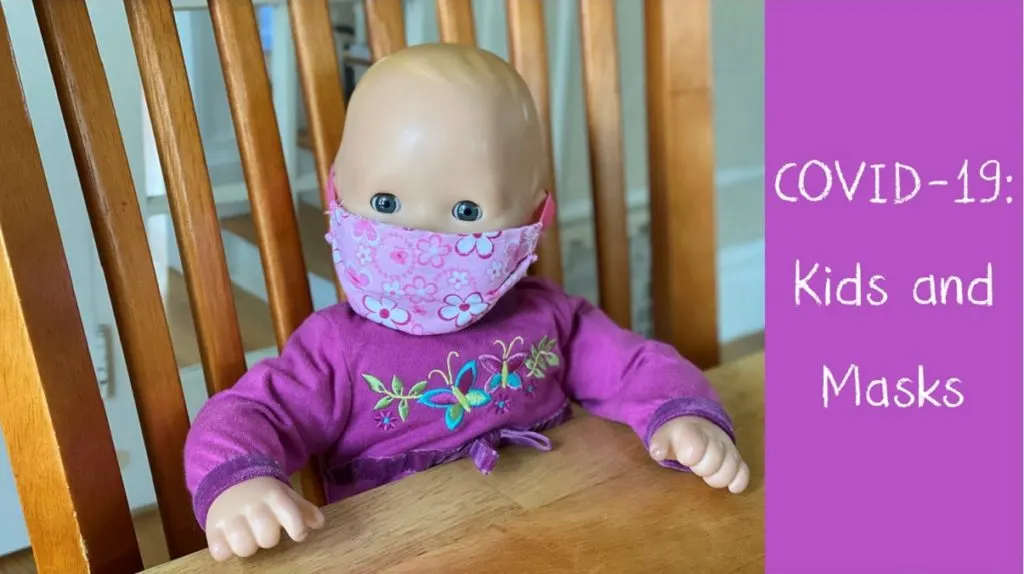
We are still in the midst of the COVID-19 pandemic. About two weeks ago, the Centers for Disease Control and Prevention (CDC) released guidelines encouraging people to wear a cloth face covering (not a medical mask—save those for health workers!) if they needed to go out in public during this time of social distancing. While the best ways to fight the spread of the virus are still
- to wash your hands,
- to stay home,
- to go only go out when it is absolutely essential,
- and to maintain 6 feet of distance between people when out,
wearing cloth masks when we do need to go out helps keep us from spreading our germs (including the coronavirus) while we’re out of our homes.
If you’re like me, one of the first things you thought of when you heard this recommendation was getting your child to wear a face covering and whether that would go over well. While we should be leaving children at home when running essential errands like grocery shopping or going to the pharmacy, sometimes that may not be possible. In that case, your child needs a cloth mask as much as you do. The exception to this guideline is that children under the age of two should not wear cloth masks (nor should anyone who has trouble breathing, or is incapacitated or unconscious, or who would be unable remove their cloth mask on their own).
You can find a great article with tips on how cloth face masks should fit, and how you should put them on and take them off, here. Those same guidelines will apply for kids, even if rules like don’t touch the mask will be even harder for them than they are for us. But here are some kid-specific tips for getting your children—especially your little ones—to wear masks:
- Be age appropriate, but explain why we have to wear a cloth face covering. (You might want to check out this downloadable book for kids about coronavirus. The author is asking for a $3 donation, but you can download the book for free.)
- Make it personal: Let them pick out the mask if you’re buying one or pick out the fabric if you’re making one.
- Make sure that you’re both wearing masks. Don’t make this something that your child has to do, but that you won’t do yourself.
- Put one on their favorite stuffed animal or toy.
- Make it game. Everyone starts with a certain number of points. For each time someone touches their mask, they lose a point. The person with the most points by the time you get home wins a prize.
- Practice at home first. Watch for them to touch their mask, and then remind them they have to wash their hands if they do.
- Paint a face (rabbit, dog, dinosaur) onto the mask and make it part of a costume.
- Do you do rewards and incentives for good behavior in your house? Add proper mask-wearing behavior to your chart. And even if this would be new for you, you can always consider rewarding proper mask-wearing behavior as a one-off thing.
- Do video calls with friends or family members during which everyone wears masks. Exposure helps normalize the wearing of cloth face coverings and helps promote proper mask-wearing behavior.
Now that you’ve got some ideas for getting your child to wear their cloth face covering, here are a few places you can buy one:
- Modern Piggy ($10, They sell out fast, so keep an eye on their Instagram page for restock dates.)
- OSA Kids (Etsy, $8)
- Lisali by Lisa (Etsy, $11)
Etsy, of course, has a huge selection of sellers. For those of you who are feeling crafty, making your own cloth face covering is pretty easy, too. Once all the fabric was washed and prepped, my husband made two for each us (one to wear, one in the wash), plus whipped up one for my daughter’s Bitty Baby in just about five hours. He used this pattern from Joann for the people masks; it includes both adult and kids’ sizes for the “pleated” style covering . Here’s a pattern for the more “fitted” style. It includes sizes for small children, older children, teenagers and women, and men.
So with all this being said, my eight-year-old has left the house with her cloth face covering on. While she had fun playing with the mask in the house, she most definitely did not like wearing it during the 30 or 45 minutes she actually had to. She actually did pretty well not touching the mask, but she was very bothered by how hot it was to wear. While we don’t anticipate her needing it again any time soon, we’ll keep on practicing, just in case. And if you have any additional tips for helping kids adjust to wearing a cloth face covering, share them in the comments!
